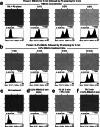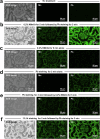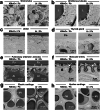KMnO4/Pb staining allows uranium free imaging of tissue architectures in low vacuum scanning electron microscopy
- PMID: 40604145
- PMCID: PMC12118665
- DOI: 10.1038/s44303-024-00045-z
KMnO4/Pb staining allows uranium free imaging of tissue architectures in low vacuum scanning electron microscopy
Abstract
Scanning electron microscopy under low-vacuum conditions allows high-resolution imaging of complex cell/tissue architectures in nonconductive specimens. However, the conventional methods for metal staining of biological specimens require harmful uranium compounds, which hampers the applications of electron microscopy. Here, we introduce a uranium-free KMnO4/Pb metal staining protocol that allows multiscale imaging of extensive cell/tissue architectures to intensive subcellular ultrastructures. The obtained image contrast was equivalent to that of Ur/Pb staining and sufficient for ultrastructural observation, showing the fine processes of podocytes in the glomerulus, which were invisible by light microscopy. The stainability in the elastic tissue indicated that the distinct histochemical properties of KMnO4 oxidation led to Pb deposition and BSE signal enhancement superior to Ur staining. Elemental analysis clarified that the determinant of the backscattered electron signal intensity was the amount of Pb deposition enhanced by KMnO4 oxidation. This user-friendly method is anticipated to create a new approach for biomedical electron microscopy.
© 2024. The Author(s).
Conflict of interest statement
Competing interests: The authors declare no competing interests.
Figures









Similar articles
-
A practical protocol for correlative confocal fluorescence and transmission electron microscopy characterization of extracellular vesicles.Microbiol Spectr. 2025 Jul;13(7):e0302624. doi: 10.1128/spectrum.03026-24. Epub 2025 May 22. Microbiol Spectr. 2025. PMID: 40401966 Free PMC article.
-
MRI software and cognitive fusion biopsies in people with suspected prostate cancer: a systematic review, network meta-analysis and cost-effectiveness analysis.Health Technol Assess. 2024 Oct;28(61):1-310. doi: 10.3310/PLFG4210. Health Technol Assess. 2024. PMID: 39367754 Free PMC article.
-
Antidepressants for pain management in adults with chronic pain: a network meta-analysis.Health Technol Assess. 2024 Oct;28(62):1-155. doi: 10.3310/MKRT2948. Health Technol Assess. 2024. PMID: 39367772 Free PMC article.
-
Systemic pharmacological treatments for chronic plaque psoriasis: a network meta-analysis.Cochrane Database Syst Rev. 2021 Apr 19;4(4):CD011535. doi: 10.1002/14651858.CD011535.pub4. Cochrane Database Syst Rev. 2021. Update in: Cochrane Database Syst Rev. 2022 May 23;5:CD011535. doi: 10.1002/14651858.CD011535.pub5. PMID: 33871055 Free PMC article. Updated.
-
[Health technology assessment report. Use of liquid-based cytology for cervical cancer precursors screening].Epidemiol Prev. 2012 Sep-Oct;36(5 Suppl 2):e1-e33. Epidemiol Prev. 2012. PMID: 23139163 Italian.
References
-
- Griffiths, G. Ultrastructure in cell biology: do we still need it? Eur. J. Cell Biol.83, 245–251 (2004). - PubMed
-
- Knott, G. & Genoud, C. Is EM dead? J. Cell Sci.126, 4545–4552 (2013). - PubMed
-
- Ochs, M. et al. Using electron microscopes to look into the lung. Histochem. Cell Biol.146, 695–707 (2016). - PubMed
-
- Danilatos, G. Mechanisms of detection and imaging in the ESEM. J. Microsc.160, 9–19 (1989).
LinkOut - more resources
Full Text Sources
